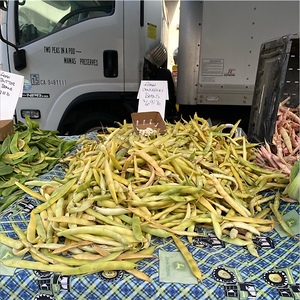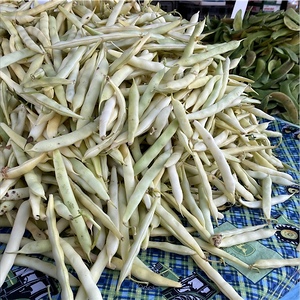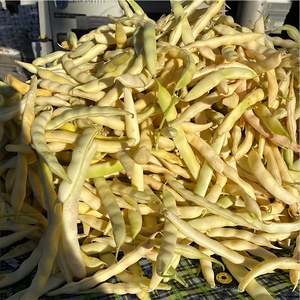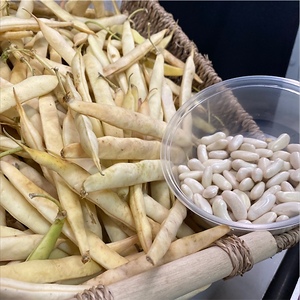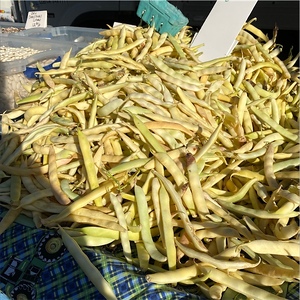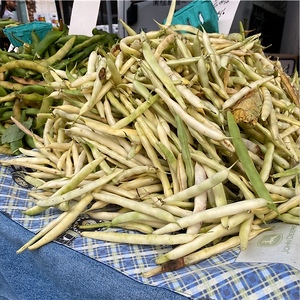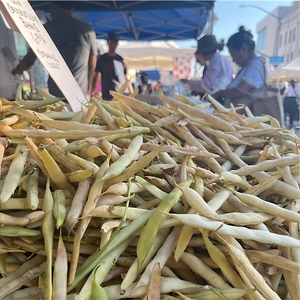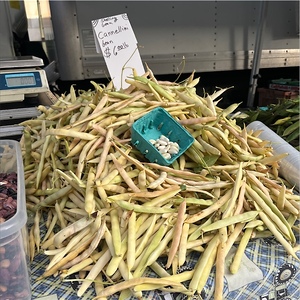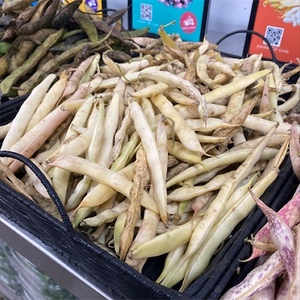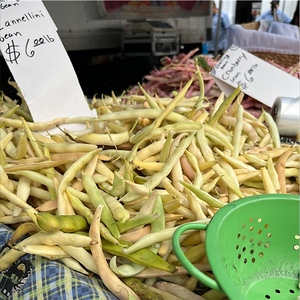


Cannelini Shelling Beans
Estimated Inventory, lb : 0
Description/Taste
Cannellini shelling beans are harvested for the edible beans or seeds contained within their long pods. Pods are green when immature and will be ready to harvest as a shelling bean when the pods turn to a pale yellow hue. Additionally when mature, the beans will overtly shape their pods with each pod housing five to eight beans. The inner beans fit tightly within the pods and can be harvested and shelled when fresh or when the pods have completely dried. Cannellini shelling beans are white in their raw state and maintain their creamy color when dried and cooked. The beans are small with an ovate to slightly curved shape. They offer a sweet, nutty flavor and hearty, creamy texture when cooked. When cooked as a dried bean, expect Cannellini shelling beans to double in size.
Seasons/Availability
Cannellini shelling beans are available in the late summer and fall months.
Current Facts
Cannellini shelling beans, botanically a part of Phaseolus vulgaris are known as an Italian heirloom bush type bean. Outside of Italy Cannellini shelling beans are often referred to simply as white beans or white kidney beans. There are a handful of different varieties of Cannellini shelling beans to be found in seed catalogs today such as silver cloud, gentec 401, montalbano, and lingot with each cultivator varying slightly in bean coloring, size, yield, and resistance to disease. While they can be used as a fresh shelling bean, Cannellini shelling beans are only available fresh for a short window when in season and are most commonly found sold in their dried and canned form.
Nutritional Value
Cannellini shelling beans are high in protein and offer some fiber, selenium, zinc, manganese, copper, folate, niacin, calcium, and iron.
Applications
Cannellini shelling beans can be used as a fresh shelling bean or as a dried bean. If used dried the beans should first be soaked before use. Cannellini shelling beans can be simmered, sautéed, roasted, fried, and braised. When boiling Cannellini shelling beans do not salt the water as this can cause their skins to become tough, rather wait to season the beans with salt to taste after cooking. Cannellini shelling beans are known to hold their shape well when cooked making them a welcome addition to bean salads, soups, and stews. Cooked beans can also be used to make pureed bean spreads and dips. Complimentary pairings include arugula, thyme, sage, parsley, basil, kale, tomatoes, wild mushrooms, garlic, peppercorns, shallots, lemon, pork, poultry, pecorino and parmesan cheeses, olive oil, and cured meats such as prosciutto and pancetta. To store keep fresh Cannellini beans wrapped in plastic and refrigerated. For best flavor fresh beans should be shelled and used within three to four days.
Ethnic/Cultural Info
Cannellini shelling beans are an important ingredient in Italian cuisine. Classic Italian preparations include minestrone, pasta e fagioli (pasta and beans), and ribollita a Tuscan white bean stew. In Tuscany beans are an integral part of the regions cuisine, so much so that the people of Tuscany have come to be known by other Italians as “mangiafagioli” or “bean eaters”. Tuscan farmers traditionally would prepare “fagioli al fiasco” (beans in a flask) by placing beans in a glass jar and slow cooking in the fireplace overnight so they would have freshly cooked beans waiting for them in the morning.
Geography/History
Cannellini shelling beans are believed to have originally been cultivated in Argentina but have long been celebrated as a staple of Italian cuisine. Cannellini shelling beans appeared in North America prior to the 1900’s and can be successfully grown in U.S. Department of Agriculture plant hardiness zones 5 to 13. Cannellini shelling beans prefer ample sunshine and cooler temperatures but are not frost tolerant. Cannellini shelling beans can be harvested and used as a fresh, or they can be left to dry on the vine. Dried on the vine pods are ready for harvest about seventy-five days after planting when the leaves of the plant have fallen, and pods are slightly shriveled and very dry.
Recipe Ideas
Recipes that include Cannelini Shelling Beans. One
| David Lebovitz |
|
Fresh Tomato and Shelling Bean Salad |



